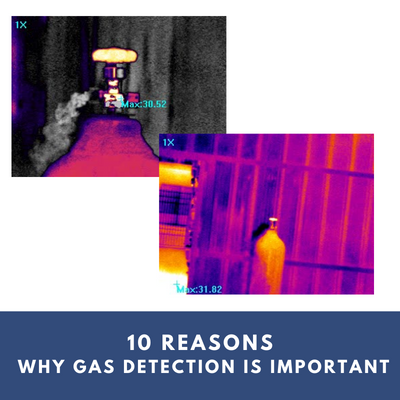
Thermal imaging and gas detection are essential tools in environmental monitoring to detect invisible threats that could potentially harm human health and the environment.
Thermal imaging uses specialized cameras to capture and visualise infared energy emitted by objects and organisms. This technology can be used to identify anomalies in energy levels, which may indicate the presence of invisible threats such as gas leaks, fires, or biological hazards.
Thermal cameras can detect gas leaks by visualising the energy levels between the leaking gas and its surroundings. Gas leaks often result in a visual change, which can be easily identified using thermal imaging. This enables early detection and prevention of potentially dangerous situations.
1. Toxic Gas Monitoring: Gas detection devices are commonly used to monitor indoor and outdoor air for toxic gases like carbon monoxide (CO), Sulphur Dioxide(SO2), nitrogen dioxide (NO2), and hydrogen sulphide (H2S). Continuous monitoring of these gases helps protect human health and ensures compliance with safety guidelines.
2. Industrial Emissions Monitoring: In industrial settings, gas detection systems are employed to monitor the emission of pollutants into the atmosphere. This helps industries maintain environmental compliance and prevent harmful gases from escaping into the air.
3. Workplace Safety: Gas detectors are essential for ensuring the safety of workers in industries where exposure to harmful gases is possible. These devices provide early warnings of gas leaks to enable prompt evacuation and prevent accidents or health issues caused by inhalation.
4. Hazardous Material Handling: Gas detectors are crucial in facilities where hazardous materials are stored or handled. They help monitor the presence of toxic or flammable gases that may be released during transportation, storage, or handling of these materials.
5. Confined Spaces: Gas detection devices are used to protect workers in confined spaces such as tanks, storage vessels, or tunnels where there is a risk of gas buildup. These devices are essential for detecting the presence of gases that can displace oxygen or pose a health hazard if inhaled.
6. Firefighting and Emergency Response: Gas detectors are utilised by firefighters and emergency responders to identify hazardous gases in fire or emergency situations. This information helps them take appropriate actions and ensure the safety of both themselves and the public.
7. Laboratory Safety: Gas detection systems are employed in laboratories to monitor the presence of hazardous gases that may be produced during experiments or stored in gas cylinders. This helps protect researchers, prevent accidents, and ensure compliance with safety protocols.
8. Mining Operations: Gas detectors are extensively used in mining operations to monitor the levels of gases such as methane or carbon monoxide in underground mines. Early detection of such gases is crucial for preventing explosions and ensuring the safety of miners.
9. Oil and Gas Industry: Gas detection devices are essential in the oil and gas industry to monitor pipelines, storage tanks, and refineries for leaks or releases of flammable or toxic gases. This helps prevent accidents, protect the environment, and maintain compliance with industry regulations.
10. Environmental Monitoring: Gas detectors are used in environmental monitoring to measure and monitor the levels of atmospheric pollutants. This data is necessary for assessing air quality, identifying pollution sources, and developing strategies for mitigating environmental impacts.
In conclusion, thermal imaging and gas detection technologies are critical for environmental monitoring and detecting invisible threats. By utilising these tools, early detection and prevention of gas leaks, fires, biological hazards, and toxic gas exposure can be achieved, significantly enhancing the safety of individuals and the environment.
Currently SATIR offers the V88-T as an OGI (Optical Gas Imaging) device. For more details visit: https://satir.com/product/satir-v88-t-new-gas-detection-thermal-camera